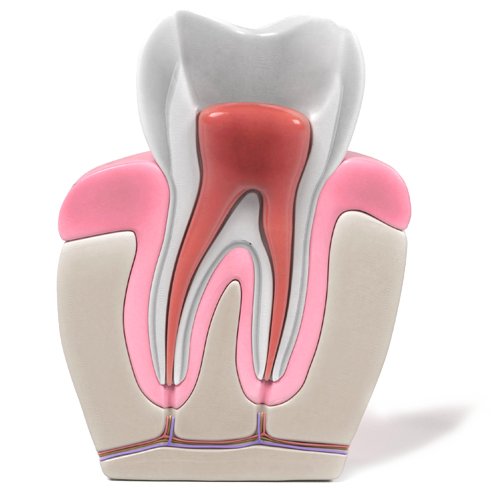Information about an endodontic treatment
What is an endodontic problem?
“Endo” is the Greek word for “within” and “odont” is the Greek word for “tooth”. An endodontic treatment therefore relates to the internal part of the tooth.
There is a hollow space within the tooth in which the nerve runs, along with blood vessels and connective tissue (= pulp). This hollow space runs deeper into the roots of the tooth, hence the term ‘root canal’.
The pulp can be irreversibly infected from the outside by, for example, a hole, leakage around an existing filling or crown, trauma (e.g following a fall), a crack in the tooth, etc. This infection process is usually accompanied by considerable pain, such as throbbing, night pain, pain from cold/heat, pain when biting, etc. If this is not treated, an infection in the root canal can eventually result in an infection of the surrounding jawbone. This can result in swelling in the surrounding tissue.
An endodontic treatment, or root canal treatment (also referred to as “pulp removal”) is necessary to remove the irreparable nerve tissue, and make the inside of the tooth completely clean once again.
The root canal needs to be re-treated if there is still infection in the tip of the root and/or the surrounding jawbone following earlier pulp removal.

What is the procedure for an endodontic treatment?
The treatment is carried out under local anaesthetic, and in most cases is painless.
The tooth is then isolated with a small operating field (rubber dam), to avoid contamination by saliva and microbes, and offer protection for the patient against the rinsing agents and instruments which are used during the treatment.
After isolation, a small opening is made at the top of the tooth in order to access the infected nerve in the root canals. Magnification with a microscope is essential at this point. Using flexible files, the canals are then shaped and chemically cleaned to remove the irritated pulp and/or already present bacteria. These canals are then filled up to the tip of the root, so that there is no more room for bacteria.
Finally, the tooth is sealed to prevent new infection by bacteria.
Why has my dentist referred me to an endodontist?
The endodontist has undergone additional training for 3 years after their general studies to be a general dentist, which already lasts 5 years, with a 1 year work placement. This extra training is necessary because endodontic treatment is often complex treatment requiring additional proficiency and special equipment, such as the use of the operating microscope. Scientific studies show that there is a 95% chance of survival for the parts of the teeth having undergone endodontic treatment, if they have been treated with the right expertise.
The roots are the ‘foundation’ of the crown of the tooth, and it is vital that infected root canals are treated appropriately, not only for the good general health of the patient, but in order for them to be able to eat comfortably.


